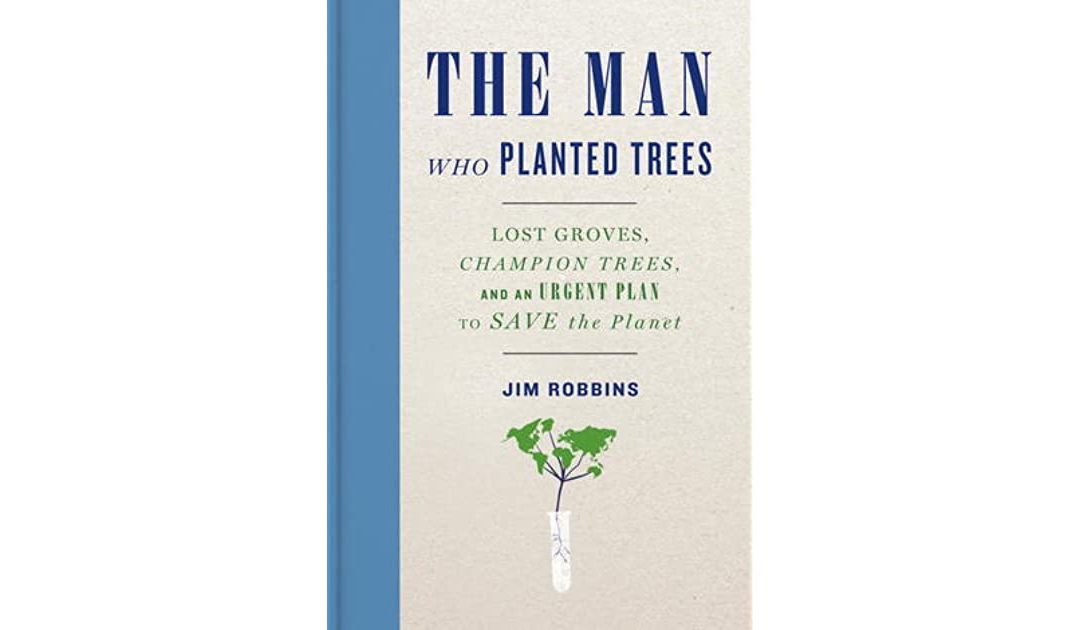The Man Who Planted Trees: Lost Groves, Champion Trees, and an Urgent Plan to Save the Planet, by Jim Robbins. (Spiegel & Grau, New York, 2012.)
Jim Robbins was incredulous when David Milarch first told him he was cloning ‘champion trees’ because angels had told him to during a near-death experience.
“I thought he was joking or spinning a yarn, but he said it all with a straight face,” Robbins said.
Robbins did some research on near-death experiences, and finally decided to believe Milarch. Not just because he thought his tale might possibly be true, but also because the idea of cloning giant trees, that had already survived many changing conditions, made good sense.
“When we look at the trees around us,” Milarch told him, “we’re looking at the runts, the leftovers.” The vast majority of the big ones have been cut down. “The whole country should be forested coast to coast with these giants, not with the puny, scraggly, miserable mess we call our forests. We don’t realize what we’ve lost.”
Milarch said the angels wanted him to clone the biggest and best – the champions – of all the tree species in the country, and that he should plant them far and wide, to help the planet survive global warming.
The handful of biggest, oldest trees still standing may have the strongest genetic tendencies and therefore the resilience to survive the coming rapid, stressful changes in climate.
“The DNA that may be best suited for the tree’s journey into an uncertain future on a warming planet has all but vanished, just when we need it most,” Robbins explains.
A seasoned science reporter for more than 30 years, Robbins specialized in writing science-based articles for the New York Times, Scientific American, Audubon, and Smithsonian, among others. He uses both his science background and skill in storytelling to evaluate and explain Milarch’s plan, and the ups and downs of Milarch’s path towards this goal for the past 20 years.
Robbins’ interest is partly motivated by a very personal experience of climate change – seeing millions of Ponderosa pine trees die, around his Montana home and region, from a rapid and unstoppable infestation of mountain pine beetles. Climate change has vastly increased the mountain pine beetle’s range and greatly lengthened their cycle of activity. In recent times, they have devastated forests all over North America.
But the devastation caused by humans is far greater, he says. We have felled entire forests without learning basic things about how they function, or how badly we need them to preserve the life-sustaining balance of our ecosystem.
“… more than 90 per cent of America’s old-growth forest is gone and is still being cut, and some 80 per cent of the world’s has vanished. Yet we have only begun – only begun – to understand the ecological role these forests play or what secrets might be locked away in their genes.”
Though Robbins once thought tree-planting was at best a feel-good activity, “In the last few years… as I have read many dozens of articles and books and interviewed scientists here and abroad, my thinking on the issue has changed. Planting trees may be the single most important ecotechnology that we have to put the broken pieces of our planet back together.”
Trees, he adds, “are ecosystem engineers that create the conditions for other forms of life to exist, on every level.”
This is a fascinating and very readable book, which details Milarch’s work to fulfill his mission, often with no staff and no money.
Robbins shares dramatic stories about specific champion trees, and introduces some of the other professionals who have collaborated with Milarch, such as botanist-author Diana Beresford-Kroeger (whose film, Call of the Forest, is also reviewed on this site).
He includes some of the science we do know about trees, such as their beneficial aerosols, medicinal effects, and ‘ecosystem services’ like phytoremediation, the ability of trees and plants to clean up toxic land.
Robbins also covers:
- Research that shows trees change in cycles geared to the alignment of the planets;
- Studies on the importance of forests in maintaining the Earth’s magnetic field;
- A “tree savant” who travels around the world finding the biggest trees, and who helped Milarch find stumps of some of the biggest redwoods that ever lived, which were then successfully cloned.
- What it takes to clone ancient trees, including scientific techniques, sometimes prayer, and specially trained tree climbers to gather the plant material. ‘Clones’ are cuttings or plant material taken from a tree and assisted to grow roots. The new sapling is genetically identical to the tree it came from. A seedling, on the other hand, may have only 50 per cent of the same DNA.
- A “bioplan” for the future – replanting biodiverse forests, and reducing exotic species, which may be attractive but don’t help sustain birds, insects, and our native ecosystems.
Robbins concludes: “We can wait around for someone else to solve the problem of climate change and the range of other environmental problems we face – from toxic waste to air pollution to dead zones in the oceans, to the precipitous decline in biodiversity – or we can take matters into our own hands and plant trees.
“It may not be the best time to plant a tree,” he adds, “but, as the proverb says, there is no better time.”
This book is a great read – entertaining, informative, and highly motivating. Worth reading and re-reading!
